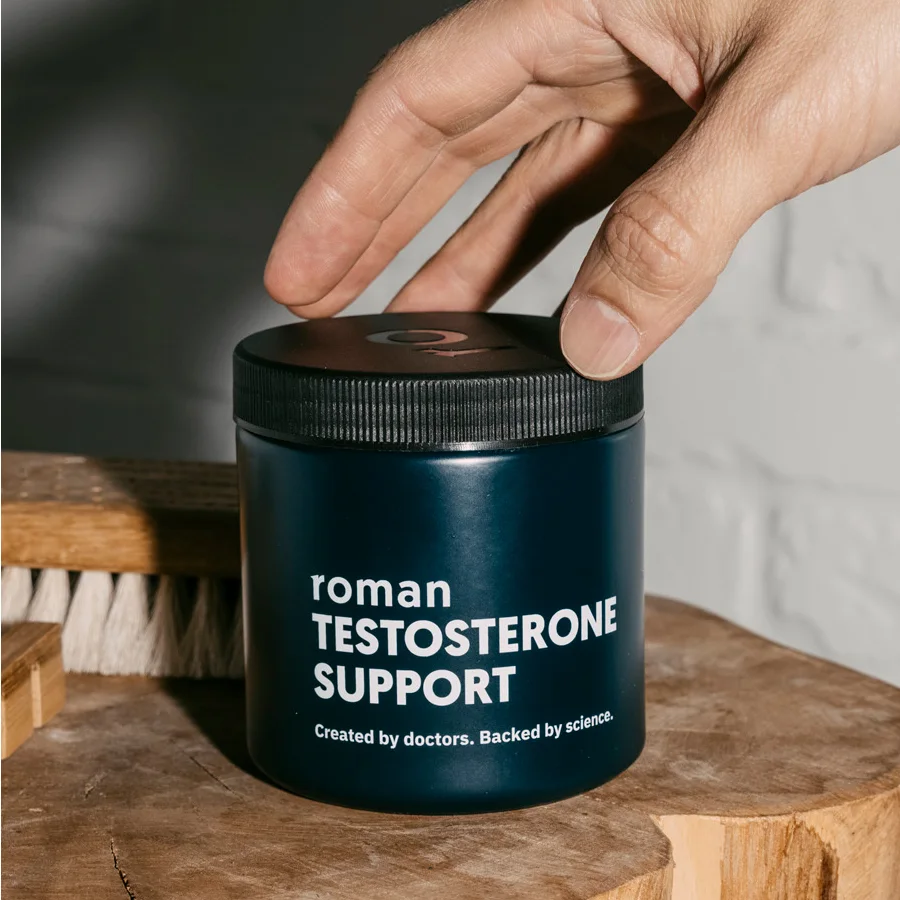Here's what we'll cover
Here's what we'll cover
Here's what we'll cover
Most likely, you’ve heard of professional athletes and olympians using anabolic steroids, and the scandals that ensue. But, anabolic steroids serve a purpose beyond athletic performance enhancement. Healthcare providers prescribe anabolic steroids to treat medical conditions like low testosterone. Continue reading to learn more about the (legal and illegal) uses of anabolic steroids, what they are, and how they differ from testosterone.
What are anabolic steroids?
Anabolic steroids are synthetic forms of testosterone, the primary male sex hormone (although all people have testosterone). You may also see them described by another name: anabolic-androgenic steroids. Because they resemble testosterone, testosterone precursors, or related compounds, they can cause many of the same effects that testosterone causes in the body, like increasing muscle size and strength (Ganesan, 2022).
When people talk about anabolic steroids, they’re usually referring to drugs that were developed to have more of an anabolic effect (i.e., muscle growth) than an androgenic effect (i.e., male sex characteristics).
Approximately 3–4 million individuals in the United States, mostly men, abuse anabolic steroids at some point in their lives. Those who abuse these drugs typically take doses much higher than recommended, leading to significant side effects (Pope, 2017).
While abusing anabolic steroids for their performance-enhancing capabilities is illegal, they are legal when a medical provider prescribes them to you to treat an underlying medical condition. Anabolic steroids aren’t the same as corticosteroids (such as prednisone), often prescribed to treat inflammatory conditions like asthma, rheumatoid arthritis, and eczema.
How do anabolic steroids work?
Anabolic steroids work by binding to androgen (sex hormone) receptors in the brain, just like natural testosterone. This affects pathways that influence male characteristics and activates certain cells that produce the proteins that build muscle mass (Ganesan, 2022).
Types of anabolic steroids
Anabolic steroids come in several forms, including pills, injections, implanted pellets, creams, and gels.
There are many different types of anabolic steroids. Even those legally used to treat medical conditions can be abused if taken inappropriately.
Three main types of testosterone are prescribed to medically treat low testosterone levels: testosterone enanthate, testosterone cypionate, and testosterone undecanoate. Nandrolone, another compound, was one of the first anabolic steroids to be used as a performance-enhancing drug by athletes (Ganesan, 2022).
Other types of anabolic steroids include 17-alpha-alkylated androgens, like stanozolol (brand name Winstrol), oxandrolone (brand name Anavar), oxymetholone (brand name Anadrol), and fluoxymesterone (brand name Androxy) (Ganesan, 2022).
Street names for these drugs include Arnolds, gym candy, pumpers, roids, and stackers.
Are anabolic steroids legal in the US?
Anabolic steroids are not illegal drugs, but anabolic steroid abuse is illegal.
When not used as performance-enhancing drugs, anabolic steroids have legitimate medical uses and are legal. However, the FDA does classify these medicines as schedule III drugs, similar to opiates, so you will be under close supervision from your healthcare provider when taking them. Anabolic steroids are FDA-approved for several medical uses, including (Ganesan, 2022):
Hormone conditions, like hypogonadism (low testosterone): If you’re diagnosed with low testosterone, your healthcare provider may prescribe testosterone replacement therapy (TRT) in the form of injections, a gel rubbed onto the skin, or a patch to wear.
Delayed puberty: Providers may prescribe a course of testosterone injections for boys who haven’t gone through puberty by a certain age, providing a boost in growth and sexual maturity.
Conditions that lead to muscle loss, including cancer and HIV: Providers sometimes prescribe steroids to patients experiencing muscle wasting related to their illnesses.
Anabolic steroid abuse
Most sports ban anabolic steroids and other performance-enhancing drug use.
But professional athletes are not the only ones who abuse anabolic steroids. Some people use them illegally to enhance their athletic performance or physical appearance. Athletes and bodybuilders might use steroids for a competitive advantage, even in high schools; other people may just want to look more muscular.
A recent study showed that approximately 3 to 4 million Americans have used anabolic steroids at some point (nearly all of them men). About 20% of teenagers have also admitted to using anabolic steroids. Unfortunately, anabolic steroid abuse can have long-lasting consequences: nearly 1 million American men have become dependent on anabolic steroids, requiring higher and higher doses (NIDA, 2018; Pope, 2017).
According to the National Institute on Drug Abuse (NIDA), people abuse anabolic steroids in three common ways (NIDA, 2018):
Stacking: People take multiple types of steroids simultaneously, possibly mixing oral and injectable versions; some believe this will boost the steroid effects.
Cycling: The user takes steroids for a set time (i.e., 6 to 12 weeks), then stops for several weeks before resuming steroid use.
Pyramiding: Steroid users start a steroid cycle with a low dose, building to a maximum dose partway through, then tapering off the drugs by the end.
Plateauing: Users try to avoid developing a tolerance to the drugs by alternating, overlapping, or substituting one anabolic steroid with another.
No data supports any of these techniques, and there is no evidence that any of these can prevent you from having negative side effects.
Effects of anabolic steroid abuse
Abusing anabolic steroids can have numerous harmful side effects, including (Ganesan, 2022):
Severe acne
Mood swings and aggression (a.k.a. "roid rage")
Testicle shrinking
High blood pressure
Enlarged male breasts (gynecomastia)
Urinary problems
Enlargement of the clitoris
Menstrual cycle changes
Increased red blood cell count
Lower levels of “good” cholesterol (HDL) and higher levels of “bad” cholesterol (LDL)
Body hair and facial hair growth and deepening of the voice in women; baldness in men
Low sperm count
Sex drive changes
Risks of anabolic steroids
Many people who take anabolic steroids illegally order them online from overseas pharmacies, which means there’s no way of truly knowing their purity or strength.
Additionally, using anabolic steroids can lead to a substance abuse disorder, where you have trouble stopping the drugs even if they are causing harm.
Long-term health problems from using anabolic steroids include serious medical conditions like heart disease, kidney problems, liver disease, and blood clots, potentially leading to heart attacks and strokes (NIDA, 2018).
Anabolic steroid withdrawal
Withdrawal symptoms are also a risk of illegal anabolic steroid use.
Because anabolic steroids bind to some of the same receptors as testosterone, they can make your body stop producing its own testosterone. If this keeps up long enough, it can cause that pathway to shut down, also called hypogonadism. Hypogonadism can cause symptoms like depression, fatigue, decreased libido, and sexual dysfunction, and can last for weeks to months after stopping the steroids.
Some people may work with their healthcare provider to use a medication called Clomid to help mitigate withdrawal symptoms (called post-cycle therapy, or PCT).
Anabolic steroids vs. testosterone
Testosterone is technically an anabolic steroid since it has muscle-building properties.
People who use anabolic steroids for non-medical reasons typically take amounts much higher than the recommended therapeutic doses. Also, some forms of anabolic steroids, like nandrolone, were created specifically for their performance-enhancing abilities and not to supplement people with low testosterone levels.
Testosterone requires a prescription from your healthcare provider, and testosterone replacement therapy is a medically supervised process. So, any products you see advertised online without a prescription are probably not testosterone, and should be avoided.
Like all medication, testosterone and anabolic steroids should be taken exactly as prescribed by a healthcare provider. Abusing anabolic steroids may lead to many harmful side effects, including substance abuse disorder. If you have concerns about low testosterone, make an appointment with your healthcare provider, and steer clear of risky counterfeit testosterone.
DISCLAIMER
If you have any medical questions or concerns, please talk to your healthcare provider. The articles on Health Guide are underpinned by peer-reviewed research and information drawn from medical societies and governmental agencies. However, they are not a substitute for professional medical advice, diagnosis, or treatment.
References
Ganesan, K., & Rahman, S., Zito, P. M. (2022). Anabolic steroids. StatPearls . Retrieved on Nov. 15, 2022 from https://www.ncbi.nlm.nih.gov/books/NBK482418/
National Institute on Drug Abuse (NIDA). (2018). Anabolic steroids drug facts . Retrieved on Jan. 18, 2022 from https://www.drugabuse.gov/publications/drugfacts/anabolic-steroids
Pope, H. G., Khalsa, J. H., & Bhasin, S. (2017). Body image disorders and abuse of anabolic-androgenic steroids among men. JAMA , 317 (1), 23–24. doi:10.1001/jama.2016.17441. Retrieved from https://www.ncbi.nlm.nih.gov/pubmed/27930760










